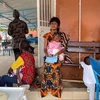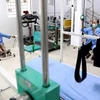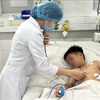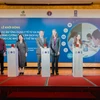Vietnamese Deputy Prime Minister Truong Vinh Trong delivered a speech at the UN General Assembly High Level Meeting on HIV/AIDS in New York on June 9 (Hanoi time), marking suggestions on how to strengthen the efficiency of HIV/AIDS prevention.
“The international community must remain vigilant and ensure necessary resources for national and international responses to HIV/AIDS,” he said.
HIV/AIDS is now the biggest challenge posed to poor and developing countries, therefore, the international community should pay special attention and support HIV/AIDS prevention efforts in these countries, he added.
The Vietnamese representative emphasised the urgent need to implement comprehensive prevention measures, including education, communication and awareness improvement, especially among young people.
HIV/AIDS patients should gain access to better health care services, especially ART and Methadone, he said, adding that conditions should be created for producing low-cost ART and Methadone through technological transfer and aid.
“It is very important to implement early diagnosis and uninterrupted treatment measures for HIV/AIDS infected people,” he stressed.
According to Deputy PM Trong, with Vietnam ’s great efforts, the number of HIV/AIDS patients accounts for only 0.26 percent of the population and the country has also seen initial results in controlling HIV/AIDS.
Over the past two years, the number of people who die of the disease has dropped from 6,000 to 2,500 per year, Trong said.
Vietnam has issued the Law on HIV/AIDS Prevention and Control and many other legal documents on this issue, encouraging and creating favourable conditions for the greater participation of people and social organisations in the fight against HIV virus, he added.
He stressed that the Vietnamese government and people highly valued the important assistance and effective cooperation of the UN, especially the Joint UN Programme on HIV/AIDS (UNAIDS), international funds and organisations, for Vietnam ’s prevention and control efforts over the past years.
“The Vietnamese government and people are strongly committed to realising national and international objectives on accessing and popularising HIV/AIDS prevention, treatment and care measures as well as the UN’s latest initiatives on no new HIV carriers, no discrimination and no death of HIV/AIDS,” the Deputy PM said.
He also expressed his hope that Vietnam will receive continued support and close and effective cooperation from the UN’s bodies and member countries as well as international organisations in this effort.
More than 30 heads of State and government along with 3,000 representatives from international, non-governmental and social organisations, development partners and people living with HIV/AIDS throughout the world attended the UN General Assembly High Level Meeting on HIV/AIDS, which opened in New York on June 8.
The meeting includes a plenum, five sessions of UN committees and 40 sidelines events, which aim to review progresses and challenges in the fight against HIV/AIDS during the past 30 years as well as discuss future global responses to this disease in the next five years.
In his opening remarks, UN General Assembly President Joseph Deiss affirmed that it’s decisive time for the fight against HIV/AIDS, adding that over the past three decades, more than 60 million people have b een infected with HIV and at least 25 million of them have died and over 16 million children have lost their parents due to the disease.
Therefore, the meeting offers an important opportunity for UN members to reaffirm commitments to enhance joint actions for the fight against HIV/AIDS, he said.
UN Secretary-General Ban Ki-moon affirmed that the HIV/AIDS fight is not only the one against disease but also the struggle for human rights and gender equality.
The meeting is an appeal to all partners for tightening global solidarity furthermost, considering it the only way to boost the access and popularisation of HIV/AIDS prevention and treatment measures and care for HIV/AIDS patients in 2015, he said.
Michel Sidibe, Executive Director of the Joint UN Programme on HIV/AIDS (UNAIDS), highlighted the international community’s common successes in HIV/AIDS prevention over the past 30 years, saying that the rate of new HIV infected people on the globe fell by 25 percent compared to that of 10 years ago, the number of people who died of the disease decreased by 20 percent over the past five years and 6.6 million people in low-income and middle-income countries were provided with HIV treatment.
However, there are still 34 million people in the world living with HIV, the highest level over the past three decades, and 9 million HIV carriers in poor countries are waiting for treatment, he said, adding that about 330,000 children in poor nations are born with HIV/AIDS every year./.
“The international community must remain vigilant and ensure necessary resources for national and international responses to HIV/AIDS,” he said.
HIV/AIDS is now the biggest challenge posed to poor and developing countries, therefore, the international community should pay special attention and support HIV/AIDS prevention efforts in these countries, he added.
The Vietnamese representative emphasised the urgent need to implement comprehensive prevention measures, including education, communication and awareness improvement, especially among young people.
HIV/AIDS patients should gain access to better health care services, especially ART and Methadone, he said, adding that conditions should be created for producing low-cost ART and Methadone through technological transfer and aid.
“It is very important to implement early diagnosis and uninterrupted treatment measures for HIV/AIDS infected people,” he stressed.
According to Deputy PM Trong, with Vietnam ’s great efforts, the number of HIV/AIDS patients accounts for only 0.26 percent of the population and the country has also seen initial results in controlling HIV/AIDS.
Over the past two years, the number of people who die of the disease has dropped from 6,000 to 2,500 per year, Trong said.
Vietnam has issued the Law on HIV/AIDS Prevention and Control and many other legal documents on this issue, encouraging and creating favourable conditions for the greater participation of people and social organisations in the fight against HIV virus, he added.
He stressed that the Vietnamese government and people highly valued the important assistance and effective cooperation of the UN, especially the Joint UN Programme on HIV/AIDS (UNAIDS), international funds and organisations, for Vietnam ’s prevention and control efforts over the past years.
“The Vietnamese government and people are strongly committed to realising national and international objectives on accessing and popularising HIV/AIDS prevention, treatment and care measures as well as the UN’s latest initiatives on no new HIV carriers, no discrimination and no death of HIV/AIDS,” the Deputy PM said.
He also expressed his hope that Vietnam will receive continued support and close and effective cooperation from the UN’s bodies and member countries as well as international organisations in this effort.
More than 30 heads of State and government along with 3,000 representatives from international, non-governmental and social organisations, development partners and people living with HIV/AIDS throughout the world attended the UN General Assembly High Level Meeting on HIV/AIDS, which opened in New York on June 8.
The meeting includes a plenum, five sessions of UN committees and 40 sidelines events, which aim to review progresses and challenges in the fight against HIV/AIDS during the past 30 years as well as discuss future global responses to this disease in the next five years.
In his opening remarks, UN General Assembly President Joseph Deiss affirmed that it’s decisive time for the fight against HIV/AIDS, adding that over the past three decades, more than 60 million people have b een infected with HIV and at least 25 million of them have died and over 16 million children have lost their parents due to the disease.
Therefore, the meeting offers an important opportunity for UN members to reaffirm commitments to enhance joint actions for the fight against HIV/AIDS, he said.
UN Secretary-General Ban Ki-moon affirmed that the HIV/AIDS fight is not only the one against disease but also the struggle for human rights and gender equality.
The meeting is an appeal to all partners for tightening global solidarity furthermost, considering it the only way to boost the access and popularisation of HIV/AIDS prevention and treatment measures and care for HIV/AIDS patients in 2015, he said.
Michel Sidibe, Executive Director of the Joint UN Programme on HIV/AIDS (UNAIDS), highlighted the international community’s common successes in HIV/AIDS prevention over the past 30 years, saying that the rate of new HIV infected people on the globe fell by 25 percent compared to that of 10 years ago, the number of people who died of the disease decreased by 20 percent over the past five years and 6.6 million people in low-income and middle-income countries were provided with HIV treatment.
However, there are still 34 million people in the world living with HIV, the highest level over the past three decades, and 9 million HIV carriers in poor countries are waiting for treatment, he said, adding that about 330,000 children in poor nations are born with HIV/AIDS every year./.



















